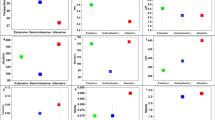Abstract
Dover sole (Solea solea L.) were examined for parasites at the White Fish Authority (WFA) fish farm at Hunterston, Ayrshire, Scotland. The most important parasites appeared to be the two blood-feeding ectoparasites Lernaeocera sp., a copepod, and Hemibdella soleae, an ichthyobdellid leech, and the haematoprotozoan Haemogregarina simondi. The anaemia and general malaise of the sole investigated was attributed partly to general stress and the debilitating effects of transfer from the wild into an aquaculture system and partly to the impact of the parasites observed.
Similar content being viewed by others
References
Anderson JIW, Conroy DA (1970) Vibrio disease in marine fishes. In: S.F. Snieszko (ed) Symposium on Diseases of Fishes and Shellfishes American Fishery Society Special Publication No. 5, Washington DC, pp 266–272
Henry H (1913) A summary of the blood parasites of British sea-fish. J Pathol Bacteriol Cambridge 18:218–219
Kearn GC (1963) Feeding in some monogenean skin parasites. J Mar Biol Assoc UK 43:749–766
Kirmse P (1978) Haematoprotozoan parasites of marine fish with special reference to mariculture. Ph.D. thesis, University of Stirling, Scotland
Kirmse P (1980) Observations on the pathogenicity of Haemogregarina sachai Kirmse, 1978 in farmed turbot Scophthalmus maximus (L.). J Fish Dis 3:101–114
Laird M, Morgan RP (1973) Haemogregarina platessae Lebailly (=H. achiri Saunders) from the hogchoker in Maryland. J Parasitol 59:736–738
Lebailly C (1960) Recherches sur les hématozoaires parasites de teleostéens marins. Arch Parasitol 10:348–404
Llewellyn LC (1965) Some aspects of the biology of the marine leech Hemibdella soleae. Proc Zool Soc London 145:509–528
McVicar AH, MacKenzie K (1977) Effects of different systems of monoculture on marine fish parasites. In: Cherret JM, Sagar GR (eds) Origins of Pest, Parasite, Disease and Weed Problems. Blackwell Sci Publ, pp 163–182
Mulcahy MF (1975) Fish blood changes associated with disease: a haematological study of pike lymphoma and salmon ulcerative dermal necrosis. In: Ribelin WE, Migaki C (eds) The Pathology of Fishes, University of Wisconsin Press
Neumann RO (1909) Studien über protozoische Blutparasiten im Blut von Meeresfischen. Z Hyg Infektionskr 64:1–113
Noble ER (1957) Seasonal variations in hostparasite relations between fish and their protozoa. J Mar Biol Assoc UK 36:143–155
Slinn DJ (1967) An infestation of adult Lernaeocera (Copepoda) on wild sole (Solea soled) kept under hatchery conditions. J Mar Biol Assoc UK 50:787–800
Smith CE (1968) Haematological changes in Coho Salmon fed a folic acid deficient diet. J Fish Res Board Can 25:151–156
Author information
Authors and Affiliations
Rights and permissions
About this article
Cite this article
Kirmse, P. Important parasites of dover sole (Solea solea L.) kept under mariculture conditions. Parasitol Res 73, 466–471 (1987). https://doi.org/10.1007/BF00538206
Accepted:
Issue Date:
DOI: https://doi.org/10.1007/BF00538206




